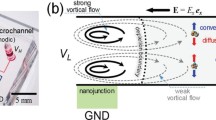Abstract
Since the concentration of target molecules contained in most reagents in analytical chemistry experiments is lower than the minimum concentration required for subsequent detection, it is necessary for sample enrichment. Electrokinetic trapping that utilizes the principle of ion concentration polarization to achieve biomacromolecular enrichment is the most efficient. In this paper, based on the Poisson–Nernst–Plank equation, a novel design of nanochannel structure in a micro–nanofluidic preconcentrator for electrokinetic ion enrichment is carried out by numerical simulation. The results show that the enrichment process can be divided into three stages: enrichment generation, enrichment promotion and enrichment breakdown when the applied voltage is increased. Importantly, by comparing the six different structure nanochannels (straight line type, square wave type, rectangular type, circle type, zigzag type and multi-wave type), we found that the enrichment ratio produced by the rectangular nanochannel is the highest of the six nanochannels, which is 20.7 times. Rectangular nanochannel requires the lowest applied voltage to achieve the highest enrichment ratio. This work provides a novel design method and theoretical basis for the design of detection equipment in ultra-low concentration molecular detection tasks.






Similar content being viewed by others
References
Han W, Chen X, Hu Z, Yang K (2018) Three-dimensional numerical simulation of a droplet generation in a double T-junction microchannel. J Micro/Nanolithogr MEMS MOEMS 17(2):025502
Han W, Chen X (2019) Numerical simulation of the droplet formation in a T-junction microchannel by a level-set method. Aust J Chem 71(12):957–964
Han W, Chen X (2019) New insights into the pressure during the merged droplet formation in the squeezing time. Chem Eng Res Des 145:213–225
Zhang S, Chen X (2019) Secondary bonding of PMMA micromixer with high-pressure. Microchem J 144:339–344
Zhang S, Chen X, Wu Z, Zheng Y (2019) Numerical study on stagger Koch fractal baffles micromixer. Int J Heat Mass Transf 133:1065–1073
Wang X, Zhu C, Fu T, Ma Y (2014) Critical lengths for the transition of bubble breakup in microfluidic T-junctions. Chem Eng Sci 111:244–254
Timung S, Chaudhuri J, Borthakur MP, Mandal TK, Biswas G, Bandyopadhyay D (2017) Electric field mediated spraying of miniaturized droplets inside microchannel. Electrophoresis 38(11):1450–1457
Santra S, Das S, Das SS, Chakraborty S (2018) Surfactant-induced retardation in lateral migration of droplets in a microfluidic confinement. Microfluid Nanofluid 22(8):88
Anna SL, Bontoux N, Stone HA (2003) Formation of dispersions using “flow focusing” in microchannels. Appl Phys Lett 82(3):364–366
Kim SH, Kim JW, Kim DH, Han SH, Weitz DA (2013) Enhanced-throughput production of polymersomes using a parallelized capillary microfluidic device. Microfluid Nanofluid 14(3–4):509–514
Burgi DS, Chien RL (1991) Optimization in sample stacking for high-performance capillary electrophoresis. Anal Chem 63(18):2042–2047
Cui H, Horiuchi K, Dutta P, Ivory CF (2005) Multistage isoelectric focusing in a polymeric microfluidic chip. Anal Chem 77(24):7878–7886
Gebauer P, Boček P (2000) Recent progress in capillary isotachophoresis. Electrophoresis Int J 21(18):3898–3904
Asbury CL, Van Den Engh G (1998) Trapping of DNA in nonuniform oscillating electric fields. Biophys J 74(2):1024–1030
Kim SJ, Ko SH, Kang KH, Han J (2010) Direct seawater desalination by ion concentration polarization. Nat Nanotechnol 5(4):297
Yeh LH, Zhang M, Hu N, Joo SW, Qian S, Hsu JP (2012) Electrokinetic ion and fluid transport in nanopores functionalized by polyelectrolyte brushes. Nanoscale 4(16):5169–5177
Choi E, Kwon K, Lee SJ, Kim D, Park J (2015) Non-equilibrium electrokinetic micromixer with 3D nanochannel networks. Lab Chip 15(8):1794–1798
Gong L, Ouyang W, Li Z, Han J (2018) Direct numerical simulation of continuous lithium extraction from high Mg2+/Li+ ratio brines using microfluidic channels with ion concentration polarization. J Membr Sci 556:34–41
MacDonald BD, Gong MM, Zhang P, Sinton D (2014) Out-of-plane ion concentration polarization for scalable water desalination. Lab Chip 14(4):681–685
Li M, Anand RK (2016) Recent advancements in ion concentration polarization. Analyst 141(12):3496–3510
Pu Q, Yun J, Temkin H, Liu S (2004) Ion-enrichment and ion-depletion effect of nanochannel structures. Nano Lett 4(6):1099–1103
Wang JY, Xu Z, Li YK, Liu C, Liu JS, Chen L, Du L, Wang LD (2013) Nanopore density effect of polyacrylamide gel plug on electrokinetic ion enrichment in a micro-nanofluidic chip. Appl Phys Lett 103(4):043103
Jain T, Rasera BC, Guerrero RJS, Boutilier MS, O’hern SC, Idrobo JC, Karnik R (2015) Heterogeneous sub-continuum ionic transport in statistically isolated graphene nanopores. Nat Nanotechnol 10(12):1053
Yang C, Hinkle P, Menestrina J, Vlassiouk IV, Siwy ZS (2016) Polarization of gold in nanopores leads to ion current rectification. J Phys Chem Lett 7(20):4152–4158
Prakash S, Zambrano HA, Rangharajan KK, Rosenthal-Kim E, Vasquez N, Conlisk AT (2016) Electrokinetic transport of monovalent and divalent cations in silica nanochannels. Microfluid Nanofluid 20(1):8
Ma C, Xu W, Wichert WR, Bohn PW (2016) Ion accumulation and migration effects on redox cycling in nanopore electrode arrays at low ionic strength. ACS Nano 10(3):3658–3664
Han W, Chen X (2019) Nano-electrokinetic ion enrichment in a micro-nanofluidic preconcentrator with nanochannel’s Cantor fractal wall structure. Appl Nanosci. https://doi.org/10.1007/s13204-019-01049-7
Han W, Chen X (2019) Nano-electrokinetic ion enrichment of highly viscous fluids in micro-nanochannel. Chem Eng Process Process Intensif 143:107626
Wang Y, Pant K, Chen Z, Wang G, Diffey WF, Ashley P, Sundaram S (2009) Numerical analysis of electrokinetic transport in micro-nanofluidic interconnect preconcentrator in hydrodynamic flow. Microfluid Nanofluid 7(5):683
Wang J, Liu C, Xu Z (2016) Electrokinetic ion transport in confined micro-nanochannel. Electrophoresis 37(5–6):769–774
Acknowledgements
This work was supported by Liaoning Natural Science Foundation (2019-MS-169), the Key Project of Department of Education of Liaoning Province (JZL201715401) and Liaoning BaiQianWan Talents Program. We sincerely thank Prof. Chong Liu for his kind guidance.
Author information
Authors and Affiliations
Corresponding author
Ethics declarations
Conflict of interest
The authors declare no conflict of interest.
Additional information
Technical Editor: Erick de Moraes Franklin, Ph.D.
Publisher's Note
Springer Nature remains neutral with regard to jurisdictional claims in published maps and institutional affiliations.
Rights and permissions
About this article
Cite this article
Han, W., Chen, X. A novel design of nanochannel structure in a micro–nanofluidic preconcentrator for electrokinetic ion enrichment. J Braz. Soc. Mech. Sci. Eng. 42, 49 (2020). https://doi.org/10.1007/s40430-019-2136-6
Received:
Accepted:
Published:
DOI: https://doi.org/10.1007/s40430-019-2136-6




